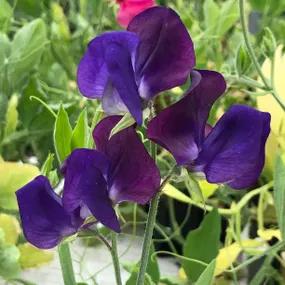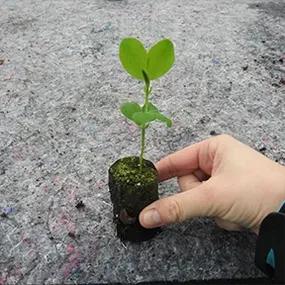'Lord Nelson' Sweet Pea Seedlings
The details
- Colour: navy/purple
- Stem: short
- Height: 2m
- Type: Heirloom Grandiflora
- Scent: highly scented
- Flowering: May to August
- Planting Months: March-June
Recommended extras
Description
Lord Nelson Sweet Pea
It is hard to describe Lord Nelson's colour - a cross between Elizabeth Taylor's eyes and a tropical sea on a cloudy day - suffice to say they are a deep violet, navy colour of real depth and beauty. The petals are slightly veined which gives the small but plentiful flowers a look of fragility which entirely belies this extraordinarily tough seadog. The flowers cover the sturdy stems and are so highly scented that they will fill your garden with perfume, and then your house if they are planted nearby.
Browse our list of sweet peas.
Our Sweet Peas are delivered in purpose-designed, recycled cardboard packaging, and are ready to be planted out when you get them.
We generally send them out between March and May, but we will email you with the likely delivery timescale once you have placed your order.
Features
- Colour: navy/violet-purple
- Stem: short
- Height: 2m
- Type: Heirloom Grandiflora
- Scent: highly scented
- Flowering: May to August
- Planting Months: March-June
In Your Garden Design
The colour of this sweet pea should not be confined to below decks in the vegetable garden but should be there like a great wave of colour in your borders trailed over a tepee or some such. Lord Nelson flowers so prolifically and its exotic blue works well with pale blues, lavenders and pastels to bright golds, reds or silvers. Try harbouring Lord Nelson next to a shrub rose like or intertwined with his honeysuckle for an out of this world scent sensation. Other old-fashioned sweet peas include the lovely Flora Norton, King Edward V11 or Mrs Collier as suitable first mates or another port of call could be to grow some of the more modern Spencer varieties as a contrast.
Did You Know?
Lord Nelson was the Admiral who both won and was killed at Trafalgar in 1805, now immortalised annually in this sweet pea. It was introduced in 1907 by Henry Eckford's sweet pea breeding programme at Isaac House in Wiltshire, and remains an extraordinarily popular.
Cultivation Instructions
Lord Nelson Sweet Peas do best in well worked, moisture retentive soil. Adding organic matter really makes a difference and is best done the autumn before. But on the day is very much better than not at all. Your plants will do best in open ground, but you can get good results planting Sweet Peas in window boxes and pots of sufficient size - allow at least 3 litres per plant and remember that these are quite deep-rooted plants. In containers, the ideal planting mix is 50% compost, 40% topsoil and 10% well-rotted manure. Ordinary potting compost is OK, but you will get fewer flowers.
A range of supports can be used from twiggy branches to willow wigwams to posts with netting stretched between. Whatever you use, do the construction work before planting. Think about the position - Sweet Peas can cope with a little shade but flower better in full sun.
Space plants about 30 cm apart and about 5 cm from their supports. The hole should be deep enough to plant the full length of the rootball and allow enough so the soil finishes level with the lowest pair of leaves. Check to make sure they are climbing well every week or so, as they grow quickly. Tie into their supports if not.
Sweet Peas biggest need is for water - they are incredibly thirsty plants. So water well after planting and make sure they never completely dry out. They are greedy too so you will lengthen their flowering period if you give them a high potash and phosphate fertiliser every 7-10 days once buds begin to form. Home-made comfrey liquid is perfect or Tomorite will do - especially if you are on a sandy soil.
Cut the flowers as they develop pick them, otherwise they run to seed and stop flowering.



